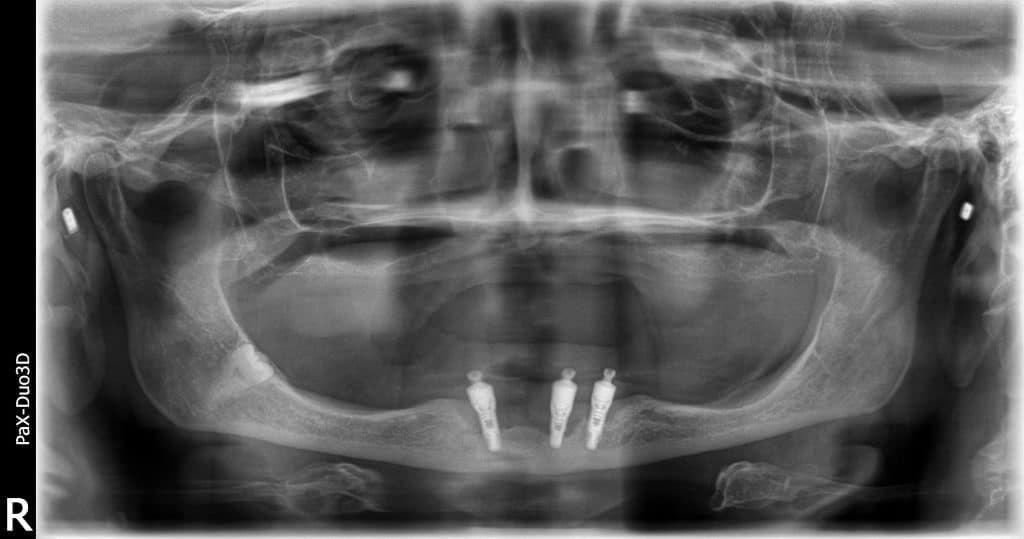8 Common All-on-X Dental Implant Problems
Written by: Dr. Ramsey Amin
What is an “All-on-X” fixed bridge (commonly referred to as an “All-on-4” or “All-on-6”)?
Various terms are used to describe bridges fixed on dental implants on the internet nowadays. However, they all refer to the same idea: a bridge supported by 4, 5, 6, or 8 implants that replace a complete set of teeth and sometimes gums. The number of implants needed for each case depends mainly on the bone structure and volume. This option allows the patient to eat and speak as if they had their natural teeth without the inconvenience of removing them from their mouth, as with traditional dentures.
To find a dental implant expert near you, click the button below!
Here are 8 of the most common issues that occur with All-on-X dental implants.
1) Bulkiness of All-on-4 Implants
The All-on-X dental implant replaces not only your teeth but also missing gum and bone, which is why there is a pink component. This comprehensive replacement can make the implant feel bulkier than natural teeth. In some cases, zygomatic implants may add a bit more thickness to the bridge on the inside of the upper arch.
Unlike natural teeth, which are not connected, the bridge is a solid horseshoe shape. It must be connected from one side to another to provide “cross-arch stability,” which is essential for long-term success. A full set of dental implants with severe bone loss or a significant underbite or overbite may feel a bit bulkier than those with a regular bite and moderate bone loss.
2) Broken All-on-X Dental Implants
Certain materials used in All-on-4 dental implant bridges can be broken. The preferred material for the bridge is zirconia, which is highly durable when properly made. It’s important that the bridge is designed to be convex (curved outward) and easy to clean while maintaining a minimum material thickness to prevent fracture. Most fractures in an All-on-X dental implant bridge occur due to bite problems or insufficient bridge thickness from the gumline to the top of the teeth. Incorrect dimensions can lead to the bridge cracking in half. Additionally, having too many implants can also contribute to this issue.
3) Implant Failure After All-on-X Implant Bridge Inserted
Implants can fail. If an implant fails after the final bridges are installed, there are limited options to replace the implant while retaining the same bridge. Typically, if an implant fails in the middle of the bridge, it can be removed, and the All-on-X can be supported by the remaining implants.
However, if the failed implant supports the end of the bridge, the entire bridge often needs to be remade, even if multiunit abutments are used.

Failing dental implants. The bone appears to be black and missing around the 3 implants.
4) Bone Loss/Gum Recession
Exposure of the implant or abutment metal can occur, especially in lower full-arch All-on-X cases, where the abutment may show better cleanliness. If thinning gums or bone causes implant exposure, a gum graft can cover it and slow or stop recession.
Naturally thick gums can prevent this issue, though some may need gum grafts from the palate due to thin gums.
5) Infected All-on-X Dental Implants
Infections can occur post-surgery or years later. Early infections are treatable, but late infections can potentially cause bone and gum loss (peri-implantitis). Regular monitoring by a skilled dentist is crucial.
Infections often enter through pockets between bone and gum. Good daily oral hygiene and avoiding smoking/vaping are key prevention methods. Recurrence of original gum disease can happen, which sometimes can be prevented with special antibiotics around the time of surgery.
6) Reduced Sensation
Because All-on-X dental implants lack nerves, feeling your bite can be challenging. This sensation, known as “proprioception,” will normalize over time, and while you may not feel temperature changes, this is not usually a concern.
7) Altered Speech
Speech changes post-All-on-X are typically temporary, with most people adjusting after a short period. The thicker feel of the teeth may require a bit longer to adapt, but technologies like facial and digital scanning can reduce this issue. Rarely, a speech therapist may be needed.
8) Lip and Face Support
The restoration should provide proper lip and face support, determined by pretreatment diagnostics. Accurate bone leveling should support the lip or face with a fixed bridge, rather than a removable overdenture. Skillful dentistry is critical.
For those with facial wrinkles, additional skin fillers may be necessary. Prototypes can help ensure proper lip and face contouring.
Balancing lip and face support is crucial, as too much can lead to lip biting and too little to tongue biting. Ideally, the transition line between natural and implant gums should be hidden, avoiding a caved-in appearance and achieving a natural facial profile. To address dental implant problems, consult an AAID-credentialed dental implant expert for evaluation and treatment. They have the expertise to assess your needs, design a personalized plan, and complete it successfully.
Preventing All-on-X complications at home
Preventing implant complications begins with maintaining good oral hygiene. Improve your hygiene by brushing correctly. Place your toothbrush at a 45-degree angle to the gum line and move gently back and forth to ensure that the bristles work between each tooth. Since getting in between implants can be difficult, ask your doctor to recommend the most effective floss product for your implant type.
Control damaging habits like nail biting or teeth grinding. Your dentist may recommend techniques to correct these involuntary habits, such as reducing stress or wearing a night guard.
As always, avoid using tobacco, alcohol, and drugs, and schedule regular maintenance visits with your dental hygienist.
What to do if you’re experiencing dental implant problems
Sadly, it is not uncommon for dentists to need to perform “re-do” implant dentistry…saving, removing, or replacing failed dental implants with problems.
The first step to fixing all-on-X dental implant problems is to schedule a consultation with an AAID-credentialed dental implant dentist.
When you choose an AAID-credentialed dental implant expert, you can rest assured you’re choosing an expert with the education, training, and proficiency to evaluate your needs, design a personalized treatment plan, and successfully complete it. To find a dental implant expert near you, click the button below!
Dr. Ramsey Amin, DDS maintains an implant-only practice in Burbank, California. He performs all “full-scope implantology” with prosthetic reconstructions, including zygomatic and pterygoid implants. He is the President of the AAID Western District. He can be reached at https://www.burbankdentalimplants.com.
12 Questions to Ask When Choosing an Implant Dentist
A printable worksheet to take with you to your appointment

American Academy of Implant Dentistry
Copyright ©2022 American Academy of Implant Dentistry




